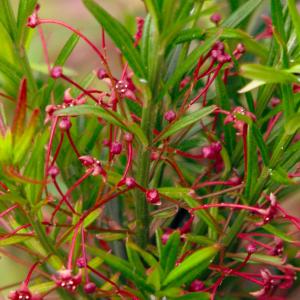文章
Miss Chen
2017年08月08日


In hydroculture, also known as hydroponics, plants grow in a soilless medium known as substrate, where the roots anchor themselves. The substrate is usually sand or gravel and, unlike the soil in traditional planting, it does not hold nutrients. Hydroponic plants get nourishment from a water-based fertilizer. For succulents, make the feeding solution weaker than you would for other hydroponic specimens.
About Succulents
Succulents are plants that retain water in their leaves or stems, such as the cactus species. Adapted to dry climates, succulents look slightly to very swollen -- depending on the specimen -- because of the moisture they hold inside for times of drought.
Growing Succulents Hydroponically
Douglas Peckenpaugh, author of the book "Hydroponic Solutions, Volume 1," says that gardeners have to follow two rules to successfully grow succulents in hydroculture: Dilute the water-based fertilizer to half strength and use a substrate that lets the liquid seep through. River sand, gravel, perlite and vermiculite are good options. Buy the material of your choice sealed in a commercial package to guarantee sterility and prevent diseases from transferring to the succulent.

Why Hydroponics
The purpose of soil in traditional gardening is to hold nutrients, according to the University of Alabama Cooperative Extension. When you water your plants, the minerals dissolve in the liquid and the roots absorb them. Plants grown hydroponically skip this step and sometimes grow faster as a result, since nourishment is always diluted and available in the water. If you capture the water-based fertilizer as it drains to feed it to your succulent multiple times, limit the food recycling to two weeks. At the end of that period, drench the substrate with water to flush old nutrient residue. After the medium becomes almost dry, begin to feed the plant a fresh batch of liquid feed.
Feeding the Succulent
To prevent saturating your succulent with water, which can kill it, allow the substrate to become mostly dry before refilling the hydroculture pot with liquid feed. But also take care to not let the plant sit in a dry medium for long periods of time. The feeding solution for hydroponic culture provides the same nutrients that traditionally grown plants need. Nitrogen, phosphorous and potassium, as well as calcium and magnesium, are needed in large amounts and considered macronutrients. Minerals such as iron, zinc and copper are trace elements required in small quantities. Recipes for you to prepare your own hydroponic feed exist, but using a commercial formula is simpler. The manufacturer calculates all the ratios among the nutrients with precision and gives you the application instructions. You just need to remember to weaken the formula to half-strength with water.
1
1
文章
Miss Chen
2017年08月06日


Description: This perennial wildflower consists of a low rosette of basal leaves up to 1½' across and a flowering stalk about 1½–2' tall. The floppy basal leaves are 6-12" long and 1/3" (8 mm.) across; they are medium to dark green, linear in shape, parallel-veined, glabrous, and smooth along their margins. Along the underside of each basal leaf, there is a prominent mid-rib. The erect central stalk is slender, light to medium green, and glabrous; it terminates in a spike-like raceme of flowers that is several inches in length. Underneath the floral spike, there are usually 1-3 bracts along the stalk. These bracts are green, linear to linear-lanceolate in shape, and up to ¾" long. Each flower is ¾–1" across, consisting of 6 tepals, 6 stamens with bright yellow anthers, and a green central ovary with a slender style. The tepals are light blue-violet to nearly white; they are oblong in shape and spread widely from the center of the flower. Each tepal (petal or petal-like sepal) has 1-3 poorly defined veins along its length.
At the base of each flower, there is a single linear bract up to ¾" long that is early-deciduous. The slender pedicel of each flower is about the same length as the bract. The flowers begin to bloom from the bottom of the raceme and continue to bloom upward toward the apex; each flower lasts only 2-3 days. The blooming period occurs from mid- to late spring and lasts about 2-3 weeks. Each fertilized flower is replaced by a 3-celled seed capsule that is about 1/3" in length and nearly as much across. Each seed capsule contains many small seeds that are black and shiny. The basal leaves turn yellow and wither away by mid-summer. The root system consists of a bulb with fibrous roots. This wildflower reproduces by reseeding itself.
Cultivation: The preference is full sun to light shade, moist conditions, and rich loamy soil. Wild Hyacinth is slow to develop, but fairly long-lived. Vegetative growth and development occurs during the cool weather of spring, when adequate moisture is essential.
Range & Habitat: Wild Hyacinth is found occasionally throughout Illinois (see Distribution Map), where it is native. Habitats include moist black soil prairies, moist savannas, moist open woodlands (particularly along the banks of streams), rocky wooded slopes, and limestone glades. This species is typically found in high quality habitats, whether prairies or woodlands.
Faunal Associations: The flowers attract their fair share of insects, including many bees and flies, and occasional butterflies and wasps. Most of these insects seek nectar from the flowers, although some short-tongued bees also collect pollen. Bee visitors include honeybees, bumblebees, Cuckoo bees (Nomada spp.), and Halictid bees (Halictus spp., Lasioglossum spp., etc.). Other floral-faunal relationships are poorly understood. White-Tailed Deer occasionally chomp off the tops of the basal leaves. Both the foliage and bulbs are not known to be toxic to mammalian herbivores.
Photographic Location: Along a woodland stream in Douglas or Coles County in east-central Illinois.
Comments: Wild Hyacinth has attractive flowers that are conspicuous during the spring. It is usually found in woodland habitats, but also occurs in prairies. Wild Hyacinth differs from the less common Camassia angusta (Prairie Hyacinth) in several ways, among them: 1) It has slightly larger flowers than the latter, 2) its flowers are usually a slightly lighter shade of blue-violet, 3) its seed capsules are about as broad as long, while Prairie Hyacinth has seed capsules that are slightly longer than broad, 4) the bracts of its flowering stalk are less persistent than those of Prairie Hyacinth, and 5) it blooms earlier in the spring.

0
0
文章
Miss Chen
2017年08月06日


Description: This perennial herbaceous plant is ½–2' tall and more or less erect; it is either unbranched or sparingly branched along the upper half of its central stem. The central stem is yellowish green or medium green and terete; it has vertical lines of short pubescence. Whorls of 4-6 leaves occur along the nodes of the central stem; because the internodes of this stem are fairly short, these leaves are produced in abundance. Relative to the orientation of the central stem, the leaves are usually ascending, although sometimes they are widely spreading or drooping. The leaves are 2-3" long, 2-3 mm. across, and linear in shape; their margins are entire (toothless) and strongly revolute (rolled downward). Sometimes whorls of smaller secondary leaves are produced from short lateral stems that develop from the axils of leaves along the central stem. The upper leaf surfaces are yellowish green or medium green and glabrous to sparsely short-pubescent; they are narrowly grooved along the middle where the midribs occur. The lower leaf surfaces are whitish green and short-pubescent; they are partially obscured by the rolled leaf margins. The leaves are sessile or they have very short petioles (less than 2 mm. long). From the axils of middle to upper leaves, umbels of flowers are produced on short peduncles (flowering stalks); there can be 1-4 umbels of flowers at each node. Individual umbels span ¾–1½" across, consisting of 7-20 pedicellate flowers.
Each flower is about 5-6 mm. across and 8-10 mm. long, consisting of 5 sepals, 5 petals, 5 hoods with horns, and a central reproductive column. The sepals are light green, short-pubescent, and lanceolate in shape; sometimes they are tinted purple toward their tips. These sepals are visible at the bases of flower buds, but they are hidden by the petals when the flowers bloom. The petals are white or greenish white, sometimes with pale purplish tints toward their tips; they are oblong-elliptic in shape and strongly declined (bent downward), curving slightly upward toward their tips. The erect white hoods are open-tubular in shape and somewhat oblique, their lower sides facing the center of the flower. The slender white horns are sickle-shaped and inwardly curved; there is one exserted horn per hood. The short reproductive column is white at its apex and light green below. The slender pedicels of the flowers are light green to nearly white, sometimes becoming purplish at their bases; they are 8-12 mm. long, terete, and short-pubescent. The peduncles are ½–1½" long, light to medium green, glabrous to short-pubescent, terete, and ascending. The blooming period occurs from early to late summer, lasting about 1-2 months. There is little or no floral scent. Afterwards, successfully cross-pollinated flowers are replaced by ascending to erect follicles (seedpods that open along one side). These follicles are 3-4" long and about ½" across; they are narrowly lanceoloid in shape and fairly smooth (lacking warts or soft prickles). At maturity during autumn or winter, these follicles split open to release their seeds to the wind. Mature seeds are about 4-5 mm. long, ovate-flattened in shape, brown, and narrowly winged along their margins; their apices have large tufts of white hair. The root system is fleshy-fibrous and long-rhizomatous. Colonies of clonal plants are often produced from the rhizomes.
Cultivation: The preference is full sun, mesic to dry conditions, and soil containing loam, clay-loam, sand, or gravel. Infertile soil is actually preferred because it reduces competition from taller plants. During hot dry weather, the lower leaves may turn yellow and fall off, or the foliage of the entire plant may become yellowish green. In open sunny areas with exposed soil, this plant can spread aggressively.
Range & Habitat: The native Whorled Milkweed occurs occasionally throughout most of Illinois, except for a few southern counties (see Distribution Map), where it is rare or absent. Habitats include upland prairies, sand prairies, gravel prairies, hill prairies, openings in rocky upland forests, sandy savannas, limestone glades, rocky bluffs along major rivers, bluegrass meadows, pastures and abandoned fields, grassy slopes along highways, and waste areas. Whorled Milkweed is a pioneer species that prefers open disturbed areas.
Faunal Associations: The nectar of the flowers attracts many kinds of insects, including honeybees, bumblebees, Halictid bees (Halictus spp., Lasioglossum spp.), Halictid cuckoo bees (Sphecodes spp.), sand-loving wasps (Tachytes spp.), weevil wasps (Cerceris spp.), Sphecid wasps (Sphex spp., Prionyx spp.), Five-banded Tiphiid Wasp (Myzinum quinquecinctum), Northern Paper Wasp (Polites fuscatus), spider wasps (Anoplius spp.), Eumenine wasps (Euodynerus spp., etc.), Syrphid flies, thick-headed flies (Physocephala spp., etc.), Tachinid flies, flesh flies (Sarcophagidae), Muscid flies, Painted Lady (Vanessa cardui) and other butterflies, Peck's Skipper (Polites peckius) and other skippers, Squash Vine Borer Moth (Melittia cucurbitae) and other moths, and Pennsylvania Soldier Beetle (Chauliognathus pennsylvanicus); sources of information include Robertson (1929) and personal observations. Among these floral visitors, bees and wasps are usually more effective at cross-pollination. Some insects feed destructively on the foliage, flowers, seedpods, and other parts of Whorled Milkweed. These species include the Small Milkweed Bug (Lygaeus kalmii), Milkweed Leaf Beetle (Labidomera clivicollis), Yellow Milkweed Aphid (Aphis nerii), and a moth, the Delicate Cycnia (Cycnia tenera). Although this insect does not occur in Illinois, in the southwestern United States, the Horsetail Milkweed Longhorn (Tetraopes discoideus) feeds on Whorled Milkweed and closely related milkweed species (Asclepias spp.); sources of information include Betz et al. (1997), Yanega (1996), and personal observations. Mammalian herbivores usually avoid the foliage of Whorled Milkweed as a food source because it is one of the more toxic milkweed species.
Photographic Location: Photographs were taken at the webmaster's wildflower garden in Urbana, Illinois, and a bluegrass meadow near Parkland College in Champaign, Illinois.
Comments: This small milkweed blooms later in the year than most milkweed species (Asclepias spp.), and its small umbels of flowers attract many kinds of insects, including butterflies. Whorled Milkweed (Asclepias verticillata) superficially resembles the common Field Horsetail (Equisetum arvense) because of its whorled linear leaves. It can be distinguished from this latter species by the milky latex of its foliage and the later development of its flowers and seedpods. Field Horsetail is a spore-bearing plant that lacks true flowers. Whorled Milkweed is readily distinguished from other milkweed species in Illinois by its more narrow leaves (only 2-3 mm. across). Narrow-leaved Milkweed (Asclepias stenophylla) is an exception, because its linear leaves are almost as narrow. However, this latter species has leaves that are alternate to nearly opposite along its stems, rather than whorled. So far, it has been found in only a few counties of western Illinois.

0
0
文章
Miss Chen
2017年08月05日


Description: This perennial plant consists of a rosette of basal leaves that are about 6-12" long and 2-3 mm. across. These erect to semi-erect leaves are linear, flat, and often slightly arching; they are medium green and glabrous. Each leaf has a poorly defined keel along its midvein, while its margins are smooth. Occasionally, flowering stalks emerge from the ground that are about the same height as the leaves, or slightly higher. These stalks are terete (round in cross-section), rather than flat, and they are held stiffly erect. Each stalk terminates in an inflorescence that has a sack-like covering spanning about ¾" across. This sack-like covering is white-membranous and ovoid in shape, tapering into a long beak at its apex. This covering splits open and withers away to reveal an umbel of about 6-12 pedicellate flowers or a similar number of sessile bulblets (frequently some combination of both).
The star-shaped flowers are about ½" across. Each flower has 6 tepals, 6 stamens, and a light green ovary with a style. The tepals are lanceolate to elliptic in shape and white, light pink, or pink. The bulblets are about ¼" long, ovoid in shape, and light green to pinkish red. Wild Garlic is especially likely to flower or have reddish bulblets in a sunny situation. The pedicels of the flowers are about ¾" long, medium green, glabrous, and terete. The blooming period occurs during early summer and lasts about 3-4 weeks. There is no noticeable floral scent, although the foliage exudes a typical onion scent. After the blooming period, the flowers are replaced by seed capsules; each capsule contains several small dark seeds. The root system consists of a bulb with thick fibrous roots, from which offsets may occasionally develop. This plant can also reproduce by its seeds and/or aerial bulblets.
Cultivation: The preference is full sun or partial sun, moist to mesic conditions, and a fertile loam. This plant also grows in light shade in wooded areas, but it is less likely to flower (instead, only aerial bulblets are produced). While growth is best in a fertile loam, other kinds of soil are tolerated. Periods of dry weather are also tolerated. While Wild Garlic spreads readily by means of offsets and bulblets, it often fails to produce viable seeds. This is one of the first plants to develop leaves during the spring.
Range & Habitat: Wild Garlic occurs in every county of Illinois, where it is native and quite common. Habitats include moist to mesic black soil prairies, upland and floodplain woodlands, moist meadows near rivers and woodlands, thickets, banks of streams, thinly wooded bluffs, abandoned fields, pastures, areas along railroads, roadsides, and waste areas. Wild Garlic has low fidelity to any particular habitat; it is often observed in degraded prairies and woodlands. This plant doesn't compete well against taller forbs, such as Canada Goldenrod (Solidago canadensis), preferring areas with less ground cover.
Faunal Associations: The nectar and pollen of the flowers attract the Onion Bee (Heriades carinatum), mason bees (Hoplitis spp.), Stelid bees (Stelis spp.), Halictid bees (Lasioglossum spp.), plasterer bees (Colletes spp.), masked bees (Hylaeus spp.), Syrphid flies, bee flies (Bombylius spp.), and wasps. Other insects suck plant juices, feed on bulbs, and other parts of Wild Garlic and other Allium spp. These species include the Green Stink Bug (Acrosternum hilaris), the Onion Plant Bug (Lindbergocapsus allii), larvae of the False Japanese Beetle (Strigoderma arbicola), the Onion Maggot (Delia antiqua), larvae of the Black Onion Fly (Tritoxa flava), larvae of the Onion Bulb Fly (Eumerus strigatus), and Onion Thrips (Thrips tabaci). During the early spring when little else is green, the vernal basal leaves of Wild Garlic are occasionally browsed by White-tailed Deer (personal observation). Other hoofed mammalian herbivores, such as cattle, will consume Wild Garlic along with grass and other plants. This can cause the milk of such animals to have an off-flavor. Rabbits avoid consumption of this plant because they appear to dislike the onion scent and spicy taste of the foliage. The foliage and bulbs are edible to humans, although the consumption of large amounts may be slightly toxic.
Photographic Location: The photographs were taken at Red Bison Railroad Prairie in Savoy, Illinois.
Comments: This is the most common species of native onion (Allium sp.) in Illinois. Wild Garlic (Allium canadense) can be readily distinguished from other native onions, such as the Cliff Onion (Allium stellatum) and Nodding Onion (Allium cernuum), by the presence of aerial bulblets in its inflorescence. An introduced onion in Illinois, Field Garlic (Allium vineale), also produces such bulblets. However, the leaves of Field Garlic are elliptic in cross-section with a hollow interior (at least at their bases), while Wild Garlic has leaves that are flat and solid throughout. There is a variety of the Wild Garlic (Allium canadense var. mobilense) that produces only flowers, rather than bulblets and flowers, or only bulblets. However, it is less common than the typical variety, as shown in the photographs.

0
1
文章
玲儿
2017年07月26日

カンパニュラ・メディウムの基本情報
学名:Campanula medium
和名:フウリンソウ(風鈴草) その他の名前:カンタベリー・ベルズ(Canterbury bells)
科名 / 属名:キキョウ科 / ホタルブクロ属
特徴
カンパニュラ・メディウムは、ヨーロッパでは古くから栽培されてきた植物です。野生種はフランス南東部からイタリア半島中部に分布し、標高0~1500mの日当たりのよい岩場に見られます。
葉はタンポポのように地面に張りつくように広がり、やがてその中心から花茎がまっすぐに伸びます。花茎は上部で枝分かれし、それぞれの先に長さ5~7cmの釣り鐘形の花を上向きに咲かせます。花色は白、ピンク、紫と多彩です。咲き終わると果実が実り、タネを残して株は完全に枯れます。
花が咲くには、十分な大きさに育った株が冬の寒さに当たることが必要でしたが、最近では寒さに当てなくても開花する園芸品種がつくり出されています。
萼が変化して二重咲きになり、外側の花びらが平らに開くものは、「カップ・アンド・ソーサー」と呼ばれています。これは変種カリカンセマ(Campanula medium var.calycanthema)で、これにもいろいろな花色があります。ほかにも多数の園芸品種があります。
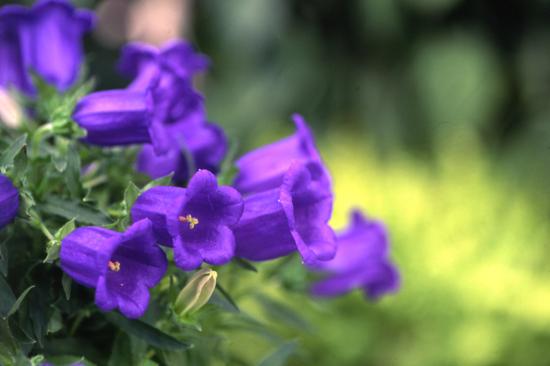
育て方のポイント
栽培環境・日当たり・置き場
風通しのよい日なたで育てます。日陰では育ちません。庭植えの場合は、土を20~30cm盛り上げたところに植えます。土には完熟堆肥を混ぜて水はけをよくし、さらに石灰を混ぜて中性~弱アルカリ性にします。
水やり
鉢植えは表土が乾いたら十分に与えます。庭植えの場合は、晴天が続いてよほど乾燥しないかぎり必要ありません。
肥料
小苗を植えつけるときに、三要素等量配合の緩効性化成肥料を3号鉢相当の株で一つまみ、元肥として施します。その後、冬を除く生育期間中に月2~3回、草花用の液体肥料を1500~2000倍に薄めて施します。鉢、または花壇への定植時に、元肥として三要素等量配合の緩効性化成肥料を3号鉢相当の株で一つまみ施します。

病気と害虫
病気:菌核病、斑点病、白絹病、根腐病、灰色かび病
6月から9月に発生する菌核病や根腐病、一年中発生することもある斑点病や褐斑細菌病、5月から9月に発生する白絹病は、株が枯れることがあります。感染した株は根ごと取り除きます。風通しと水はけをよくすると発病を抑えることができます。白絹病の場合は放置すると病原菌が土中で長期間生きて、毎年発病を繰り返します。
害虫:ヨトウムシ
ヨトウムシはヨトウガの幼虫で、葉を暴食します。主に晩春から初夏と、初秋の2回を中心に発生します。温暖な都市部では一年中見られることもあります。
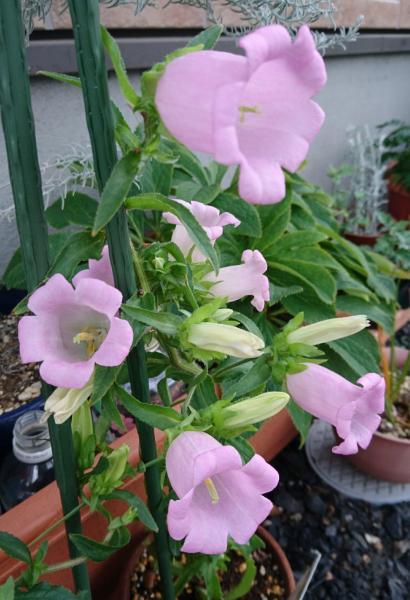
用土(鉢植え)
腐植質の混ざった水はけのよい土に石灰類を混ぜ、用土を中性から弱アルカリ性に中和して使います。市販の草花用培養土に石灰類を混ぜると、使い勝手がよく手軽です。
植えつけ、 植え替え
タネをまいた場合、発芽して本葉2~3枚の時期に3号ポットに鉢上げします。成長した苗は9月から10月上旬に、鉢か花壇に定植します。移植の際に根を傷つけないように注意しましょう。

ふやし方
タネまき:6月から7月にまきます。タネまきが遅れると、翌年に開花可能な株に育ちきらないまま冬を迎えてしまうので、必ず適期を守りましょう。タネは市販のタネまき用の用土のような清潔な土にまきます。赤玉土小粒に熱湯を注いで消毒したものでも問題ありません。密にまきすぎないように注意しましょう。
主な作業
支柱立て:花茎が伸び始めたら、支柱を立てて倒れないように支えます。
学名:Campanula medium
和名:フウリンソウ(風鈴草) その他の名前:カンタベリー・ベルズ(Canterbury bells)
科名 / 属名:キキョウ科 / ホタルブクロ属
特徴
カンパニュラ・メディウムは、ヨーロッパでは古くから栽培されてきた植物です。野生種はフランス南東部からイタリア半島中部に分布し、標高0~1500mの日当たりのよい岩場に見られます。
葉はタンポポのように地面に張りつくように広がり、やがてその中心から花茎がまっすぐに伸びます。花茎は上部で枝分かれし、それぞれの先に長さ5~7cmの釣り鐘形の花を上向きに咲かせます。花色は白、ピンク、紫と多彩です。咲き終わると果実が実り、タネを残して株は完全に枯れます。
花が咲くには、十分な大きさに育った株が冬の寒さに当たることが必要でしたが、最近では寒さに当てなくても開花する園芸品種がつくり出されています。
萼が変化して二重咲きになり、外側の花びらが平らに開くものは、「カップ・アンド・ソーサー」と呼ばれています。これは変種カリカンセマ(Campanula medium var.calycanthema)で、これにもいろいろな花色があります。ほかにも多数の園芸品種があります。

育て方のポイント
栽培環境・日当たり・置き場
風通しのよい日なたで育てます。日陰では育ちません。庭植えの場合は、土を20~30cm盛り上げたところに植えます。土には完熟堆肥を混ぜて水はけをよくし、さらに石灰を混ぜて中性~弱アルカリ性にします。
水やり
鉢植えは表土が乾いたら十分に与えます。庭植えの場合は、晴天が続いてよほど乾燥しないかぎり必要ありません。
肥料
小苗を植えつけるときに、三要素等量配合の緩効性化成肥料を3号鉢相当の株で一つまみ、元肥として施します。その後、冬を除く生育期間中に月2~3回、草花用の液体肥料を1500~2000倍に薄めて施します。鉢、または花壇への定植時に、元肥として三要素等量配合の緩効性化成肥料を3号鉢相当の株で一つまみ施します。

病気と害虫
病気:菌核病、斑点病、白絹病、根腐病、灰色かび病
6月から9月に発生する菌核病や根腐病、一年中発生することもある斑点病や褐斑細菌病、5月から9月に発生する白絹病は、株が枯れることがあります。感染した株は根ごと取り除きます。風通しと水はけをよくすると発病を抑えることができます。白絹病の場合は放置すると病原菌が土中で長期間生きて、毎年発病を繰り返します。
害虫:ヨトウムシ
ヨトウムシはヨトウガの幼虫で、葉を暴食します。主に晩春から初夏と、初秋の2回を中心に発生します。温暖な都市部では一年中見られることもあります。

用土(鉢植え)
腐植質の混ざった水はけのよい土に石灰類を混ぜ、用土を中性から弱アルカリ性に中和して使います。市販の草花用培養土に石灰類を混ぜると、使い勝手がよく手軽です。
植えつけ、 植え替え
タネをまいた場合、発芽して本葉2~3枚の時期に3号ポットに鉢上げします。成長した苗は9月から10月上旬に、鉢か花壇に定植します。移植の際に根を傷つけないように注意しましょう。

ふやし方
タネまき:6月から7月にまきます。タネまきが遅れると、翌年に開花可能な株に育ちきらないまま冬を迎えてしまうので、必ず適期を守りましょう。タネは市販のタネまき用の用土のような清潔な土にまきます。赤玉土小粒に熱湯を注いで消毒したものでも問題ありません。密にまきすぎないように注意しましょう。
主な作業
支柱立て:花茎が伸び始めたら、支柱を立てて倒れないように支えます。
0
0
文章
Abigal
2017年05月02日

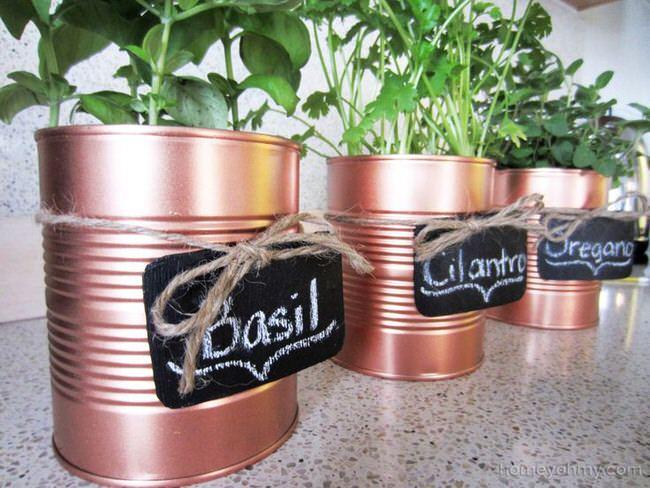
I love metal projects, and copper is a perfect medium to reflect the natural and changing state of a garden. Beautiful in all it’s forms, it is representative of how plants and gardens change through their seasons, and offer different interest at different stages. Also, it’s just really fun to work with! Relatively inexpensive, copper starts it’s life shiny and bright, and patinas over time to a lovely verdigris. Although I love that look, if you want your copper project to stay bright, simply seal it with an exterior grade clear sealer. So on to these great DIY copper garden projects that any of you can do in an afternoon! Our featured project, above, is a tutorial on how to make DIY copper tin can planters (and chalkboard tags!) from Homey Oh My! Easy and quick project with impact!
‘Tool Using Animal’ (via Instructables) made this incredible copper rain chain with copper tubing and solder. This is my fav rain chain project, and the tutorial is very complete, but I do notice he used a blow torch to solder the rings. I personally don’t own a blow torch, but it honestly gives the cleanest look, so if you have to borrow one, do! If you can’t or aren’t comfortable using one, look forward to the next project…

As promised, a copper rain chain made without a blow torch! Ex-Scapes made this DIY copper rain chain using copper wire instead of solder…
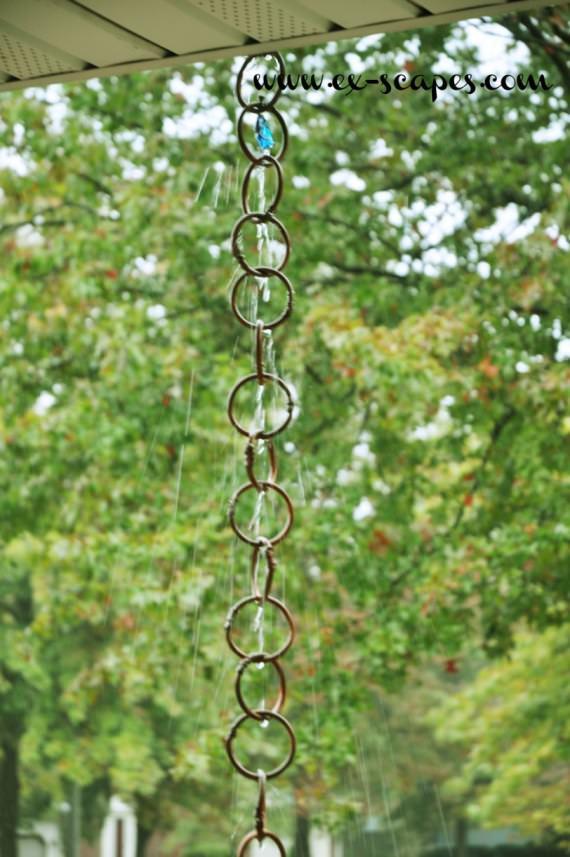
Simple, simple, simple! This copper mailbox by Sand and Sisal is a half hour project…really! What great curb appeal!
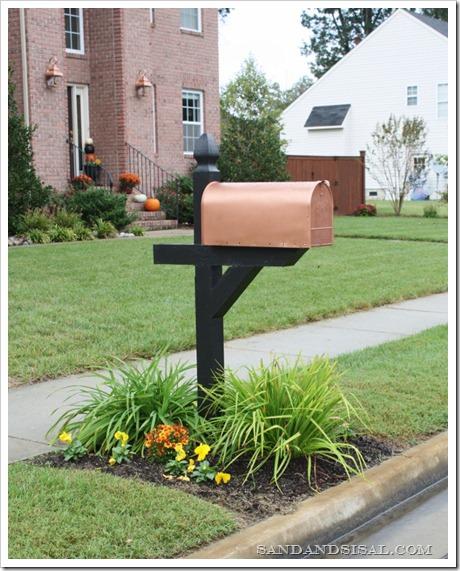
Ashley of Sugar and Cloth, and contributor at Poppytalk, created these DIY mini copper planters from copper fitting caps and a bottle of ketchup! Or catsup…whatever… Curious? Easy and cool! How about these with a moss garden?
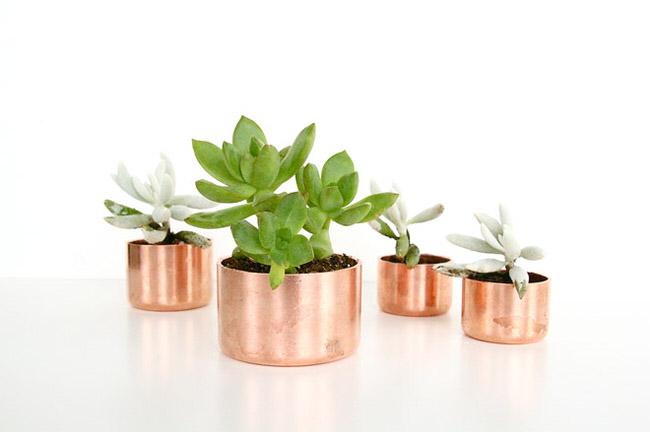
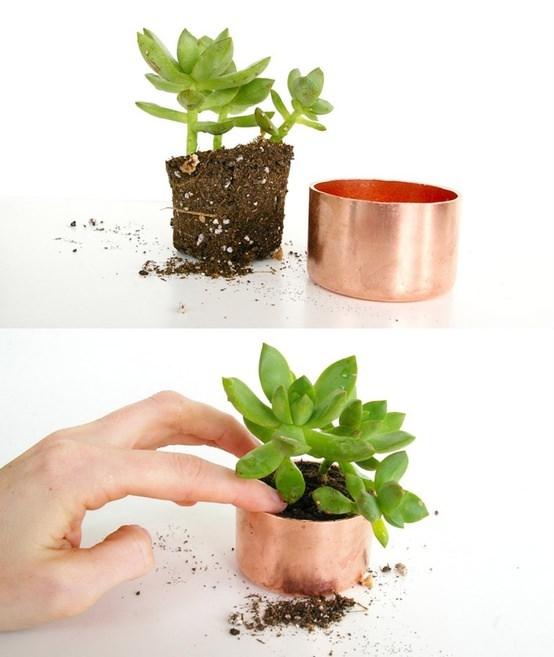
From the book, Trellises, Planters & Raised Beds from Cool Springs Press, this DIY copper coil trellis is easy and really amazing as art in the garden.

Another type of decorative copper trellis project, from Lowes. Complete directions, under $100.
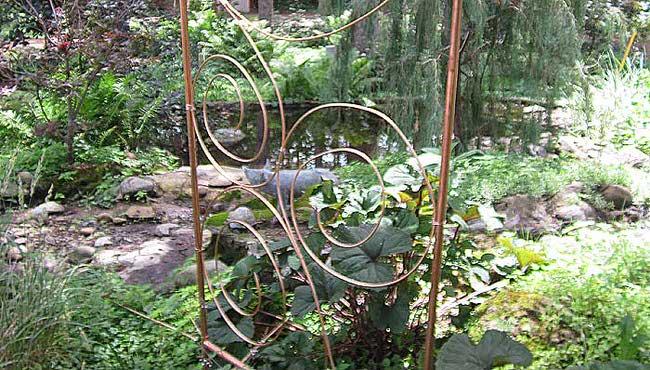
Another great project from Sand and Sisal, this DIY copper mobile is such an awesome idea, and so incredibly easy… make sure you choose the size of copper tubing that bends easily. (But not too easily!)
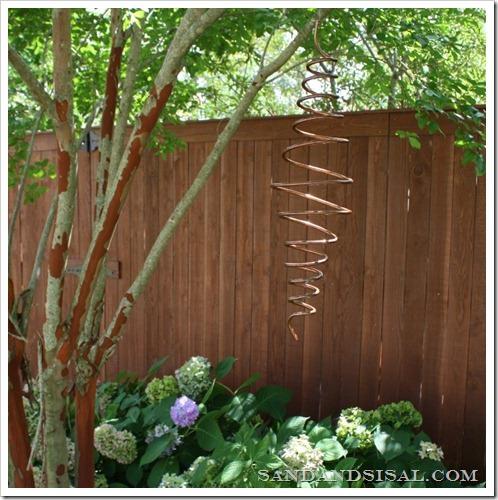
From Family Handyman, make this copper trellis for your garden from copper pipe for all your climbing plants… Can you imagine your roses, or even your cucumbers growing on this?
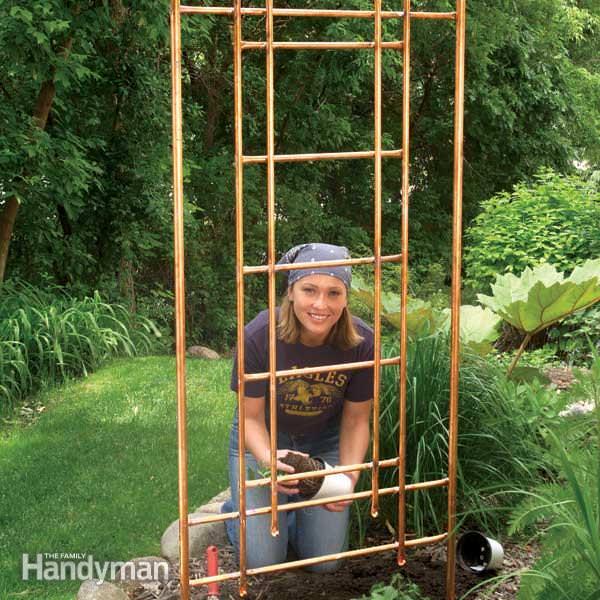
This copper tomato spiral from ‘Suzy Homefaker’ is both functional and decorative. See how she made it.
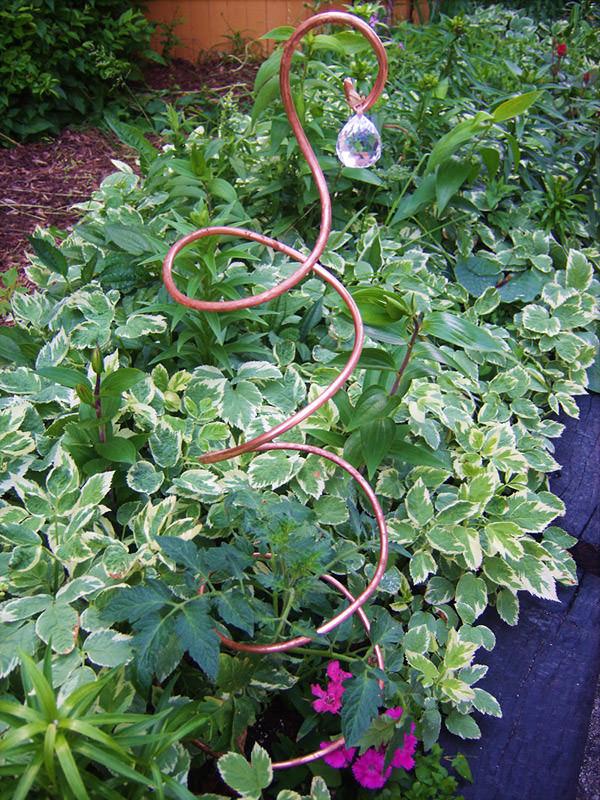
Finally, make copper wind chimes with the complete instructions by Chica and Jo. They use copper pipe, and remember your hardware store may be able to cut it for you!
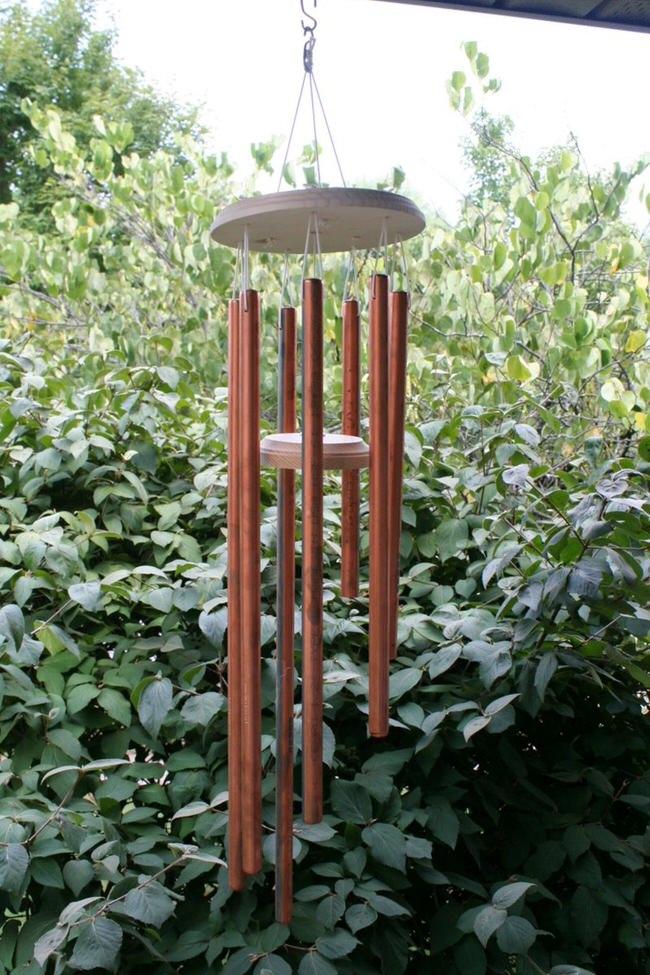
0
0
Beyond:I want to steal your copper model. It's cool.
成长记
Sierra Wilson
2017年03月22日

I new added a "Peperomia obtusifolia variegata, from Japan, medium light." in my "garden"
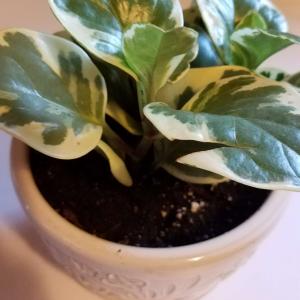

2
0
文章
lenny
2017年02月24日
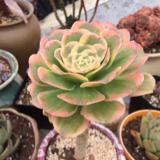
#Growing corn in containers is possible, however the yield is less than the corn grown in a #garden . Corn requires more #space than most small or medium sized containers provide. If you’re planting corn in containers, use large pots and reproduce optimum external conditions as close as possible.Choosing Containers to Grow Corn in Pots

Choose a large container that is at least 12 inches deep and wide. You can grow about four corn plants in this size of pot. Make sure your pot have enough drainage holes in the bottom.
Varieties for Growing Corn in Containers
As you grow corn in pots, choose a dwarf variety that does not exceed 4 or 5 feet (1.2 to 1.5 m) height. Some good choices are short stemmed ‘Trinity’ and ‘Sweet Painted Mountain’.
Planting
Sow four to six seeds per pot about 1 inch (2.5 cm) deep and rake a bit of soil above them. Don’t worry if the corn is planted together closely in a pot. In fact, sowing seeds closely helps in pollination and allow the corn to fruit abundantly.
Requirements
Sweet corn needs full sun, plenty of water and fertile soil to thrive. It depends on the wind for pollination, which is best achieved when the corn is planted in a block of several short rows.
Mulch around the corn to hold in moisture. Use wood chips, newspapers or grass to help prevent moisture loss. Mulching also keeps weeds to a minimum.
Soil
Corn plants require soil that retains moisture without drying out quickly but drains well enough so it doesn’t become soggy or waterlogged. A peat based potting soil works best for them.
Water
Water the plant every other day, keeping the soil constantly moist. Water is important ingredient to get sweet and soft corns, especially at the time of fruiting you’ll need to water your potted corns more.
Fertilizer
Add fertilizer after 10 weeks from sowing. Dig a hole about 2 cm in depth and diameter around each plant. Pour 1/2 tablespoons of 5-10-10 or 10-20-20 fertilizer per plant, and incorporate the soil.
Harvesting
If you know how to grow corn in pots, you can grow your own corns without the need of lot of space, usually corns are ready to harvest between 60 to 100 days after planting, depending on the variety and weather conditions.


Choose a large container that is at least 12 inches deep and wide. You can grow about four corn plants in this size of pot. Make sure your pot have enough drainage holes in the bottom.
Varieties for Growing Corn in Containers
As you grow corn in pots, choose a dwarf variety that does not exceed 4 or 5 feet (1.2 to 1.5 m) height. Some good choices are short stemmed ‘Trinity’ and ‘Sweet Painted Mountain’.
Planting
Sow four to six seeds per pot about 1 inch (2.5 cm) deep and rake a bit of soil above them. Don’t worry if the corn is planted together closely in a pot. In fact, sowing seeds closely helps in pollination and allow the corn to fruit abundantly.
Requirements
Sweet corn needs full sun, plenty of water and fertile soil to thrive. It depends on the wind for pollination, which is best achieved when the corn is planted in a block of several short rows.
Mulch around the corn to hold in moisture. Use wood chips, newspapers or grass to help prevent moisture loss. Mulching also keeps weeds to a minimum.
Soil
Corn plants require soil that retains moisture without drying out quickly but drains well enough so it doesn’t become soggy or waterlogged. A peat based potting soil works best for them.
Water
Water the plant every other day, keeping the soil constantly moist. Water is important ingredient to get sweet and soft corns, especially at the time of fruiting you’ll need to water your potted corns more.
Fertilizer
Add fertilizer after 10 weeks from sowing. Dig a hole about 2 cm in depth and diameter around each plant. Pour 1/2 tablespoons of 5-10-10 or 10-20-20 fertilizer per plant, and incorporate the soil.
Harvesting
If you know how to grow corn in pots, you can grow your own corns without the need of lot of space, usually corns are ready to harvest between 60 to 100 days after planting, depending on the variety and weather conditions.

0
0
文章
小马奥
2017年02月22日

Not only the #vegetables but #fruits can be grown in pots too. Here are 14 best fruits to #grow in pots.
Buy a disease free potted plant from a reputed nursery or online and start in a small to medium sized pot (3-5 gallons) and then repot the plant gradually into the bigger ones. A 20-25 gallon size pot is an ideal one for a fruit tree in the container.
Best Fruits To Grow In Pots1. Lemon

USDA Zones— 8-11, *can be grown in cooler zones with care in winter
Lemon trees have adapted themselves for container gardening. However, it is a tropical fruit but gardeners in cool temperate regions are also successfully growing this tangy and sour fruit in containers. Almost all the varieties are suitable but there are some that grows best in specific conditions. Read the information given in this article to grow your own lemon tree.
2. Strawberries

Strawberries are without a doubt one of the best fruits to grow in pots. The best about growing strawberries in containers is they are easy to grow, don’t require large pots or space and you can grow on your small urban balcony. You can also try to grow strawberries in tropics in winters. Check out our guide on growing strawberries here.
3. Apple

Dwarf apple trees are very suitable for growing in pots, you can even keep on a balcony or small terrace. When growing an apple tree in such a small space it would be better if you choose a self-fertile variety so that you don’t need to grow more than one plant. All the other requirements for growing apple tree in a pot is available here.
4. Pomegranate

*can be grown in cooler zones with care in winter
Pomegranate is one of the juiciest and healthiest fruits and perhaps the easiest to grow in pots because it has shallow root system when compared to other large fruit trees. If you’ve grown citrus in pot, growing pomegranates in containers can not be difficult for you too. Moreover, pomegranate is more cold hardy and easy to grow. Learn how to grow it in pot in this article.
5. Fig

0
As figs are most suitable for warm temperate regions (USDA Zones 8-10) it is best to grow a fig tree in a pot if you live in a climate where winters are harsh or you don’t have enough space. Choose an appropriate variety to grow in a pot and provide plenty of sun to your plant. Regular pruning and fertilization are necessary.
6. Nectarines and Peaches

Both the nectarines and peaches are available in dwarf varieties. Most of these dwarf varieties don’t exceed the height of 6-8 feet and are self-fertile. Some dwarf peach varieties are “Golden Gem”, “El Dorado”, “Garden Gold” and “Southern Sweet”. Dwarf nectarine varieties you can grow in pots are “Nectarcrest”, “Fantasia”.
7. Cherry

Bush cherry cultivars are suitable for container gardening. Cherries prefer a mild climate and a little water as it dislikes wet feet. However, drought and high temperatures could damage the plant as well, but it survives well in the cold. The cherry tree favors a soil that is well drained and composed of plenty of organic matter.
8. Guava

*can be grown in cooler zones with care in winter
Guava tree will delight you with its sweetly scented flowers, delicious fruits, and beautiful tropical appearance. Guava loves the sunny and warm exposure. It is a tropical plant but very much adaptable to temperate climates with moderate winter. Learn how you can grow guava tree in pot here.
9. Watermelon
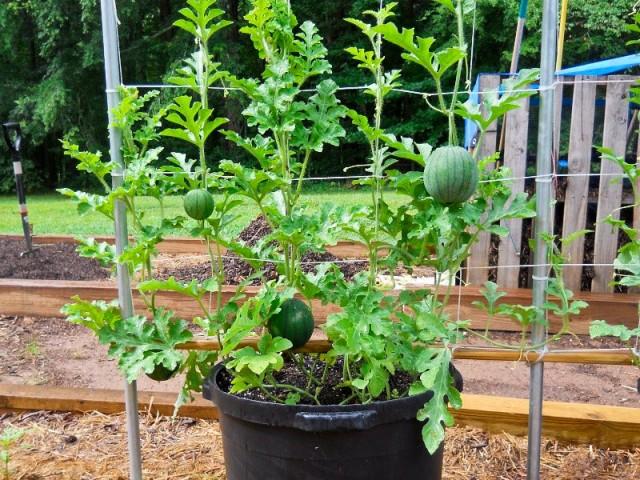
Watermelons are easy to grow in pots, all they need is a good support and well-drained potting soil. Growing watermelon is similar to cucumbers, you can find out all the information in our article.
10. Banana

Growing banana in a pot is easy and its lush green appearance can give any place a tropical look and feel. Banana trees grow in tropical and subtropical parts of the world and therefore they love full sun, heat and humidity. However, there are cultivars available that are mildly cold hardy and suitable for warm temperate zones. Find out how to grow it in a pot here.
11. Pineapple

Pineapple plants are small and compact and never grow more than 3-6 feet tall. Also, the plant has shallow roots when compared to other fruit bearing plants or trees that’s why it is possible to grow them in pots. However, pineapples require consistently warm and humid climate to thrive but you can also grow them as a houseplant in temperates, providing several hours of direct sunlight daily.
12. Raspberries

Raspberries are bit tricky and unruly to grow in containers but still everbearing varieties like “Heritage”, “Raspberry Shortcake” and “Fall Gold” are a good choice. All these varieties are self-fertile and easy to grow in pots. Here’s a useful article on growing raspberry in containers.
13. Blueberries

Growing blueberries in pots is a good idea if the soil in your garden is not acidic. Providing a potting mix for Azaleas and camellias or other acid loving plants and a large pot is essential so that your blueberry plant will grow easily and provide fruit for years.
14. Oranges and Citruses

All the oranges and citruses can be grown in pots as they are rather large shrubs or small trees. If you live in a climate where winters are mild these fruits are really easy to grow, however, you can still grow an orange tree in a cold climate with care in winter. In pots, you can grow calamondin, buddha’s hand citron, clementines orange etc.
Buy a disease free potted plant from a reputed nursery or online and start in a small to medium sized pot (3-5 gallons) and then repot the plant gradually into the bigger ones. A 20-25 gallon size pot is an ideal one for a fruit tree in the container.
Best Fruits To Grow In Pots1. Lemon

USDA Zones— 8-11, *can be grown in cooler zones with care in winter
Lemon trees have adapted themselves for container gardening. However, it is a tropical fruit but gardeners in cool temperate regions are also successfully growing this tangy and sour fruit in containers. Almost all the varieties are suitable but there are some that grows best in specific conditions. Read the information given in this article to grow your own lemon tree.
2. Strawberries

Strawberries are without a doubt one of the best fruits to grow in pots. The best about growing strawberries in containers is they are easy to grow, don’t require large pots or space and you can grow on your small urban balcony. You can also try to grow strawberries in tropics in winters. Check out our guide on growing strawberries here.
3. Apple

Dwarf apple trees are very suitable for growing in pots, you can even keep on a balcony or small terrace. When growing an apple tree in such a small space it would be better if you choose a self-fertile variety so that you don’t need to grow more than one plant. All the other requirements for growing apple tree in a pot is available here.
4. Pomegranate

*can be grown in cooler zones with care in winter
Pomegranate is one of the juiciest and healthiest fruits and perhaps the easiest to grow in pots because it has shallow root system when compared to other large fruit trees. If you’ve grown citrus in pot, growing pomegranates in containers can not be difficult for you too. Moreover, pomegranate is more cold hardy and easy to grow. Learn how to grow it in pot in this article.
5. Fig

0
As figs are most suitable for warm temperate regions (USDA Zones 8-10) it is best to grow a fig tree in a pot if you live in a climate where winters are harsh or you don’t have enough space. Choose an appropriate variety to grow in a pot and provide plenty of sun to your plant. Regular pruning and fertilization are necessary.
6. Nectarines and Peaches

Both the nectarines and peaches are available in dwarf varieties. Most of these dwarf varieties don’t exceed the height of 6-8 feet and are self-fertile. Some dwarf peach varieties are “Golden Gem”, “El Dorado”, “Garden Gold” and “Southern Sweet”. Dwarf nectarine varieties you can grow in pots are “Nectarcrest”, “Fantasia”.
7. Cherry

Bush cherry cultivars are suitable for container gardening. Cherries prefer a mild climate and a little water as it dislikes wet feet. However, drought and high temperatures could damage the plant as well, but it survives well in the cold. The cherry tree favors a soil that is well drained and composed of plenty of organic matter.
8. Guava

*can be grown in cooler zones with care in winter
Guava tree will delight you with its sweetly scented flowers, delicious fruits, and beautiful tropical appearance. Guava loves the sunny and warm exposure. It is a tropical plant but very much adaptable to temperate climates with moderate winter. Learn how you can grow guava tree in pot here.
9. Watermelon

Watermelons are easy to grow in pots, all they need is a good support and well-drained potting soil. Growing watermelon is similar to cucumbers, you can find out all the information in our article.
10. Banana

Growing banana in a pot is easy and its lush green appearance can give any place a tropical look and feel. Banana trees grow in tropical and subtropical parts of the world and therefore they love full sun, heat and humidity. However, there are cultivars available that are mildly cold hardy and suitable for warm temperate zones. Find out how to grow it in a pot here.
11. Pineapple

Pineapple plants are small and compact and never grow more than 3-6 feet tall. Also, the plant has shallow roots when compared to other fruit bearing plants or trees that’s why it is possible to grow them in pots. However, pineapples require consistently warm and humid climate to thrive but you can also grow them as a houseplant in temperates, providing several hours of direct sunlight daily.
12. Raspberries

Raspberries are bit tricky and unruly to grow in containers but still everbearing varieties like “Heritage”, “Raspberry Shortcake” and “Fall Gold” are a good choice. All these varieties are self-fertile and easy to grow in pots. Here’s a useful article on growing raspberry in containers.
13. Blueberries

Growing blueberries in pots is a good idea if the soil in your garden is not acidic. Providing a potting mix for Azaleas and camellias or other acid loving plants and a large pot is essential so that your blueberry plant will grow easily and provide fruit for years.
14. Oranges and Citruses

All the oranges and citruses can be grown in pots as they are rather large shrubs or small trees. If you live in a climate where winters are mild these fruits are really easy to grow, however, you can still grow an orange tree in a cold climate with care in winter. In pots, you can grow calamondin, buddha’s hand citron, clementines orange etc.
0
0
成长记
Plants Encyclopdias
2016年08月17日
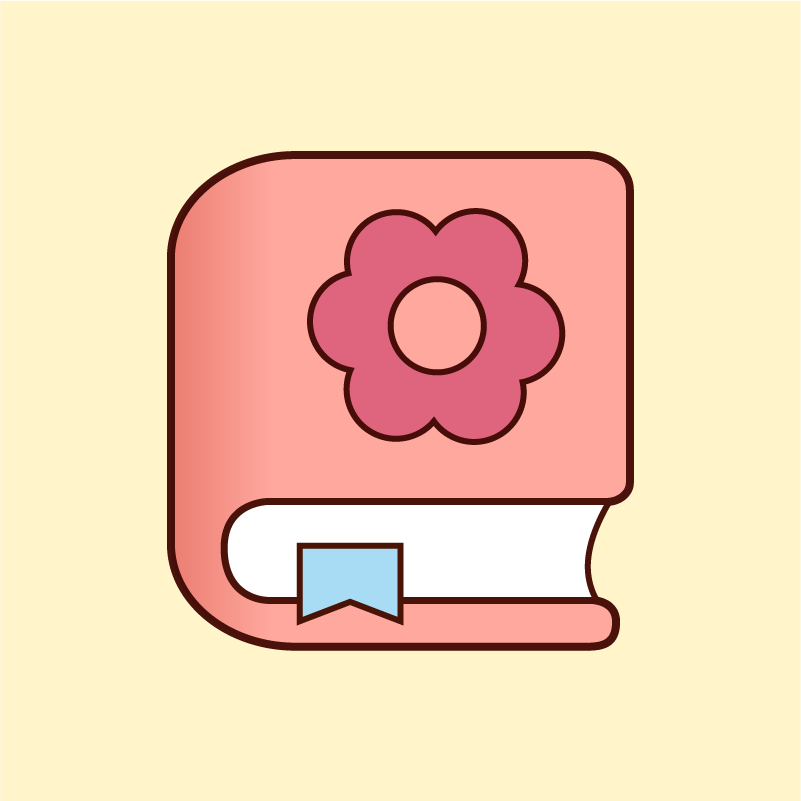
Name: Five holes plant
Latin: Monstera adansonii
Origin: South America
Plant height: 100 - 500 cm
Reproduction: #Stems
Difficulty level: #Medium
Tags: #SouthAmerica #Monsteraadansonii
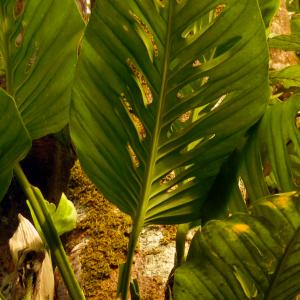
Latin: Monstera adansonii
Origin: South America
Plant height: 100 - 500 cm
Reproduction: #Stems
Difficulty level: #Medium
Tags: #SouthAmerica #Monsteraadansonii

19
1
成长记
Plants Encyclopdias
2016年08月17日

Name: Swiss cheese plant
Latin: Monstera deliciosa
Origin: South America
Plant height: 100 - 500 cm
Reproduction: #Stems
Difficulty level: #Medium
Tags: #SouthAmerica #Monsteradeliciosa
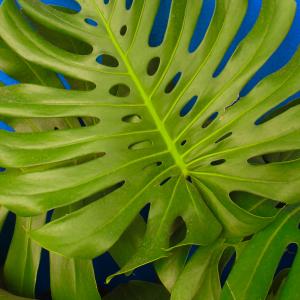
Latin: Monstera deliciosa
Origin: South America
Plant height: 100 - 500 cm
Reproduction: #Stems
Difficulty level: #Medium
Tags: #SouthAmerica #Monsteradeliciosa

20
7
成长记
Plants Encyclopdias
2016年08月17日

Name: Fortune's spindle Blondy
Latin: Euonymus fortunei
Origin: Asia
Plant height: 30 - 60 cm
Reproduction: #Seeds
Difficulty level: #Medium
Tags: #Asia #Euonymusfortunei

Latin: Euonymus fortunei
Origin: Asia
Plant height: 30 - 60 cm
Reproduction: #Seeds
Difficulty level: #Medium
Tags: #Asia #Euonymusfortunei

7
2
成长记
Plants Encyclopdias
2016年08月17日

Name: Fortune's spindle
Latin: Euonymus fortunei
Origin: Asia
Plant height: 30 - 60 cm
Reproduction: #Seeds
Difficulty level: #Medium
Tags: #Asia #Euonymusfortunei
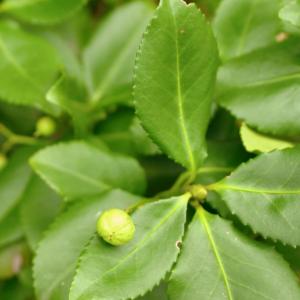
Latin: Euonymus fortunei
Origin: Asia
Plant height: 30 - 60 cm
Reproduction: #Seeds
Difficulty level: #Medium
Tags: #Asia #Euonymusfortunei

3
2



